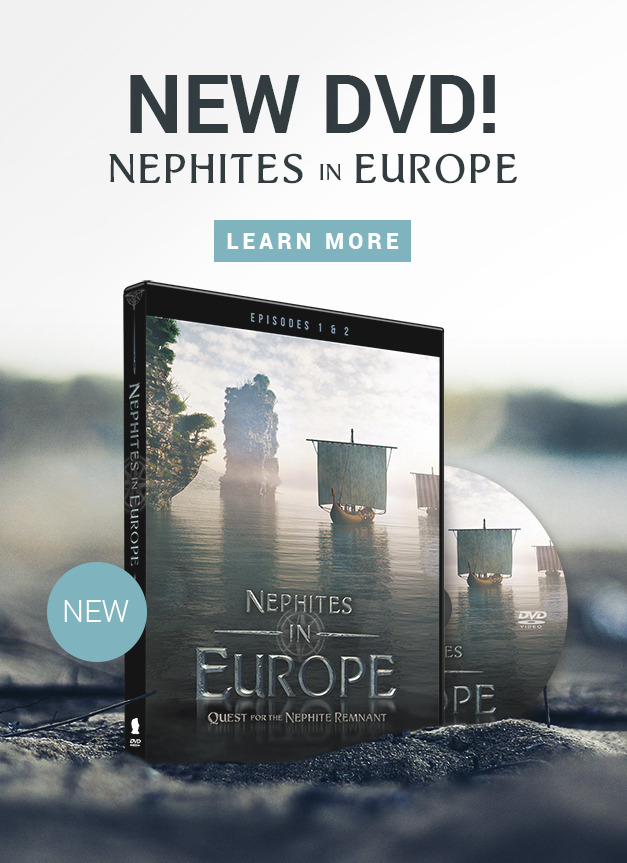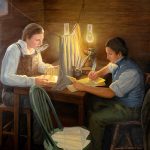Associated Locations:
- Berlin – Birthplace
Associated Dates:
- September 14, 1769 – Born
| 1 | |
|---|---|
| Born | September 14, 1769(1769-09-14) Berlin, Germany |
| Died | May 6, 1859(1859-05-06) (aged 89) Berlin, Germany |
| Resting place | Tegel House, Berlin |
| Father | Alexander George von Humboldt |
| Mother | Maria Elizabeth Colomb |
Alexander von Humboldt is one of the eminent spirits who appeared to President Wilford Woodruff in the St. George Temple on August 21, 1877. This interesting story is detailed in the Eminent Spirits Appear to Wilford Woodruff wiki.
Life Sketch from The Other Eminent Men of Wilford Woodruff
Copyright © Taken from the book: The Other Eminent Men of Wilford Woodruff. Special thanks to Vicki Jo Anderson. Please do not copy.
Father of Physical Geography 1769-1859
“Science is the mind applied to nature.”
– Alexander von Humboldt
Early Life

One day Johann von Goethe was visiting the Humboldt house for dinner. After an evening of observing and quizzing the young child, Alexander, Goethe concluded his visit by placing his hand on the boy’s head. “My child,” he said, “I believe you have a distinct talent for science.” Then Goethe turned and urged Humboldt’s father to guide Alexander into the field of natural history. Humboldt not only became on of the great scientists of all time, but he also became, with the exception of Napoleon, the most famous man in Europe in his time. Humboldt is to physical science what Goethe is to literature, and interestingly enough both were Prussian.
Friedrich Heinrich Alexander Baron von Humboldt was born into Prussian nobility in Berlin on 14 September 1769. His father was Major George von Humboldt, who had served as an officer in the Seven Year War under Frederick the Great. Alexander’s childhood was spent in the family castle of Tegel where he and his brother Wilhelm were privately tutored. Humboldt’s childhood holds no record that he was promising in health or in intellect. In fact, his older brother Wilhelm seemed to draw all the attention. Wilhelm was very precocious and Alexander was of a more quiet nature.
Humboldt’s mother’s family were Huguenots, a group of people dedicated to what they believed. His father passed away when he was about ten years of age, and his education fell to his mother who was rather particular about his tutors. One of his early tutors was a young man name Joachim Campe, who wrote Robinson der Jungere, based on Daniel Defo’s Robinson Crusoe. Campe was particularly interested in the development of the mind and not just the rote memory that was the learning style of the day. Campe’s instruction reinforced Humboldt’s natural love for explorations. “From my earliest youth, I felt an ardent desire to travel into distant regions, seldom visited by Europeans.”
When Humboldt turned fourteen, the brothers moved to Berlin to further their education at the University. Their studies covered a wide range of subjects. Humboldt particularly enjoyed the study of botany. During this time Humboldt became acquainted with George Forster, who had accompanied the celebrated navigator Captain Cook around the world as one of the ships naturalists. This acquaintance gave such dimension to Humboldt’s life that it set him on a path which led to his leading one of the world’s greatest scientific expeditions. Forster took Humboldt on an exciting tour of the Netherlands. They traveled through Paris where Humboldt, young and enthused with liberty, became deeply touched by the common people’s desire for freedom.
Humboldt’s mother directed his studies towards finance but he prepared himself to work in the mines as a mineralogist. In 1792, at the age of 23, Humboldt entered the Prussian mining service and soon became a mining leader. Since the miners were having difficulty seeing in the candle light, Humboldt worked on a solution. Designing and conducting a number of dangerous experiments, he invented a safety lamp and rescue apparatus for miners threatened with asphyxiation.
For Humboldt this was not only a time of work, but also a time of intense study and observation. He was a natural born empiricist; to measure and apply numbers with the facts, he felt, was the cornerstone of science. He believed in universal harmony and felt that nature gave him glimpses of that harmony. He wrote of how nature reveals her information:

-
-
- ”The rolling rock leaves its scratches on the mountain; the river, its channels of soil; the animal, its bones stratum; the fern and leaf, their modest epitaph in the coal. The fallen drop makes its sculpture in the mud or stone….”
-
Humboldt expressed an almost desperate concern over science not moving forward fast enough. With regret he wrote “whilst the number of accurate instruments is daily increasing, we are still ignorant of the height of many mountains and elevated plains.” It was Humboldt, who, from the enormous amount of data gathered on his extensive travels, was able to determine the elevation of the continents.
During his mother’s life he remained devoted to her and honored her request to not travel. Her death, however, left him free to follow the bent of his genius. He soon departed for Paris where he met Aime Bonpland, who was to be his companion for the next six years. He These two young scientists sought for passage with Napoleon’s scientific voyage up in Spain. The well-educated and gracious young Humboldt was immediately accepted into the courts of Spain.
Trip to the Amazon
The Spanish throne granted not only permission to Humboldt and Bonpland to travel to New Spain (America) but also granted letters of introduction to its numerous governors. In 1799, they landed in Vensuela, narrowly escaping a malignant fever that took a number of lives aboard ship. Together these knowledge-seekers made their way through pathless forest, searching caves and seeking the tops of mountain peaks. The following spring they canoed down the Amazon, passing through regions infested with jaguars, crocodiles, mosquitoes, and wild cannibal tribes.
They filled the canoes with botanical specimens. Humboldt filled volumes with notes of his observations and mapped all the areas with a talent that far exceed the tools and abilities of his day. From the Amazon they turned down the Rio Negro and into the channel of the Orinoco. On they sailed, taking a side trip through underground caverns while the roaring Orinoco flowed overhead. Nothing escaped Humboldt’s notice. Based on his observations, a large collection of his maps of North and South America was published in 1827. The accuracy with which these maps were drawn astounds geographers today.

Humboldt and Bonpland traveled and studied for five years. On the eve of their return to Europe, they were invited to visit Washington, D.C.. as guests of President Jefferson. Humboldt met several times with Jefferson and his cabinet, sharing his travels and bring them up to date on information of Mexico. His maps were of special interest as the United States was in the process of making the Louisiana Purchase from Napoleon III.
Humboldt was also the first who called for the construction of a connection water way we now call the Panama Canal. For more that fifty years he urged this advancement.
While Columbus made the discovery of America, Humboldt made the scientific discovery of America. His expedition was one of the most fruitful scientific expeditions in history. The great South America liberator Simon Bolivar, who became closely acquainted with Humboldt, gave this tribute to the great scientist. “Humboldt has done more good for America that all her conquerors.” A natural diplomat, Humboldt was often called on to advise Bolivar and helped him to chart a moderate course.
Humboldt’s Works
After the expedition, Humboldt returned to Paris, the scientific center of Europe. He he spent the next twenty years compiling his massive research. He had gathered some 60,000 plant specimens, 6,300 of which were hitherto unknown in Europe. His notes and observation extended into the many scientific fields: magnetism, meteorology, climatology, geology, mineralogy, oceanography, zoology, etc. This large work he endearingly entitled Cosmos. Humboldt eventually exhausted his fortune in publishing these volumes.
Humboldt’s research led him to significant geographical discoveries. In 1817 he was able to establish the existence of “Isothermal lines. Cartographers were surprised to see, on Humboldt’s map, that London, though as far north as Labrador, had the same mean temperature as Cincinnati, which is as far south as Lisbon. His investigations led him to origin of tropical storms. He discovered that the earth’s magnetic force decreases in intensity from the poles to the equator. This work was important for its influence on physical geography and for giving accuracy to the manner of representing natural phenomena. As a result, Humboldt is often called “Father of Geography.”

In cooperation with other noted scientists and under his gentle leadership, many scientific advancements took place in Paris. The great American naturalist Dr. Louis Agassiz spoke of Humboldt’s work in these terms: “They have as completely changed the basis of physical science, as the revolution which took place in France about the same time has changed he social condition of that land.”
Humboldt can be considered one of the last scientists whose mind could incorporate all the scientific fields. The expansive nature of his works even moved his old friend and fellow countryman, Goethe, to say: “[Humboldt] is like a fountain with many pipes. You need only to get a vessel to hold under it, and on any side refreshing streams flow at a mere touch.”
In his sixtieth year, Humboldt made an expedition to the Riley Mountains at the request of the czar. In six months time the expedition covered a distance of 9614, miles. The central Asiatic Plateau was more accurately measure and based on Humboldt’s own geological calculations, diamonds were found in the Riley Mountains.
Much of Humboldt’s time in his later years was spent as Minister for the king of Prussia. Beside his many great scientific labors, Humboldt was an indefatigable humanitarian. He was particularly cognizant of struggling gifted youth, offering them encouragement, and recommendations to universities, kings, and even presidents. These young scholars regarded themselves as “his children.” Among these young beneficiaries were Ferdinande Eisenstein, Hermann Karl Vogel, Justus von Liebig, Fritz Johann Muller, and Louis Agassiz.
He was also personally responsible for anti-slavery legislation’s in Prussia and spoke often against anti-Semitism and racism wherever it was found. It was the slavery issued that kept him from total respect for the United States. He said, “By asserting the unity of the human race we also oppose every distasteful assumption of higher and lower races of man. There are more adaptive, more highly educated and more spiritually enriched peoples, but there are none nobler than others. All are equally ordained to be free.”
To the end of his life Humboldt remained a student. “We used to see in the crowd of students,” remarked a future author, “a small, white-haired, old and happy-looking man dressed in a long brown coat. This man was Alexander von Humboldt, the “father of modern science” who came to “go through again what he had neglected in his youth.”
As he approached his ninetieth year, Humboldt’s health began to fade. One of his last visitors was the American poet Bayard Taylor. Humboldt asked him of his friend, Washington Irving. As Taylor rose to leave, Humboldt from his weakened condition, held out his hand for one last time to his departing visitor. It was the same hand that had clasped in friendship many of the leading personages of the century; Frederick the Great, Friedrich Schiller, Napoleon Bonaparte, William Pitt, Johann Goethe, Thomas Jefferson, Alexander Hamilton, Ludwig von Beethoven, and Sir Walter Scott.
The friend of every cultivated man, Humboldt sought to lose no opportunity to do all the good of which he was capable. His influence on the progress of science is incalculable.
Copyright © Taken from the book: The Other Eminent Men of Wilford Woodruff. Special thanks to Vicki Jo Anderson. Please do not copy.2







